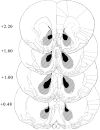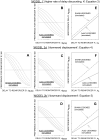Effects of quinolinic acid-induced lesions of the nucleus accumbens core on inter-temporal choice: a quantitative analysis
- PMID: 17659381
- PMCID: PMC2092416
- DOI: 10.1007/s00213-007-0882-0
Effects of quinolinic acid-induced lesions of the nucleus accumbens core on inter-temporal choice: a quantitative analysis
Abstract
Rationale: There is evidence that lesions of the nucleus accumbens core (AcbC) promote preference for smaller earlier reinforcers over larger delayed reinforcers in inter-temporal choice paradigms. It is not known whether this reflects an effect of the lesion on the rate of delay discounting, on sensitivity to reinforcer magnitude, or both.
Aim: We examined the effect of AcbC lesions on inter-temporal choice using a quantitative method that allows effects on delay discounting to be distinguished from effects on sensitivity to reinforcer size.
Materials and methods: Sixteen rats received bilateral quinolinic acid-induced lesions of the AcbC; 14 received sham lesions. They were trained under a discrete-trials progressive delay schedule to press two levers (A and B) for a sucrose solution. Responses on A delivered 50 microl of the solution after a delay d(A); responses on B delivered 100 microl after d(B). d(B) increased across blocks of trials, while d(A) was manipulated across phases of the experiment. Indifference delay d(B(50)) (value of d(B) corresponding to 50% choice of B) was estimated in each phase, and linear indifference functions (d(B(50)) vs d(A)) derived.
Results: d(B(50)) increased linearly with d(A) (r(2) > 0.95 in each group). The intercept of the indifference function was lower in the lesioned than the sham-lesioned group; slope did not differ between groups. The lesioned rats had extensive neuronal loss in the AcbC.
Conclusions: The results confirm that lesions of the AcbC promote preference for smaller, earlier reinforcers and suggest that this reflects an effect of the lesion on the rate of delay discounting.
Figures








References
-
- Ainslie G. Specious reward: a behavioral theory of impulsiveness and impulse control. Psychol Bull. 1975;82:463–496. - PubMed
-
- Bizot J, Le Bihan C, Puech AJ, Hamon M, Thiebot M. Serotonin and tolerance to delay of reward in rats. Psychopharmacology. 1999;146:400–412. - PubMed
-
- Bradshaw CM, Body S, Szabadi E. Decision-making and neuroeconomics: delayed reinforcement, neuroscience. In: Squire L, editor. New encyclopedia of neuroscience, MS#1527. Elsevier; Oxford: 2007. in press.
-
- Bowman EM, Brown VJ. Effects of excitotoxic lesions of the rat ventral striatum on the perception of reward cost. Exp Brain Res. 1998;123:439–448. - PubMed
Publication types
MeSH terms
Substances
Grants and funding
LinkOut - more resources
Full Text Sources
Miscellaneous

